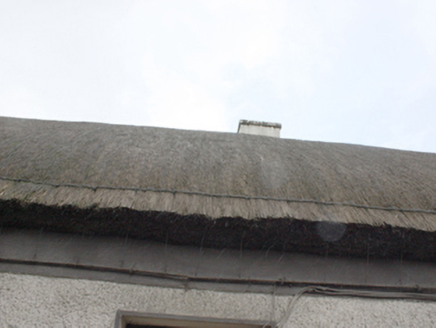Survey Data
Reg No
40805022
Rating
Regional
Categories of Special Interest
Architectural, Technical
Original Use
House
Date
1810 - 1830
Coordinates
247227, 445113
Date Recorded
08/10/2008
Date Updated
--/--/--
Description
Attached four-bay single-storey vernacular house, built c. 1820. Now out of use. Pitched thatched roof having ropes and wire mesh over secured wrought-iron bar below eaves level, and with smooth rendered chimneystacks to the east gable end and to the centre. Smooth rendered eaves course. Roughcast rendered walls to front elevation with smooth rendered plinth course and margins. Square-headed window openings with stone sills, smooth rendered reveals, and with openings now boarded\blocked. Square-headed door openings having smooth rendered reveals, and with replacement battened timber doors with glazed upper panels (now boarded). Road-fronted to the east of the centre of Carndonagh.
Appraisal
Although now sadly out of use, this charming thatched vernacular house survives in relatively good condition, and is an appealing feature on the streetscape to the east of the centre of Carndonagh. It probably originally dates to the first half of the nineteenth century, and probably was formerly one of a number of thatched dwellings located along Pound Street based on the form of other altered buildings in the streetscape. Modest in scale, it exhibits the simple and functional form of vernacular building in Ireland. Of particular interest in the survival of the thatch roof, although recently renewed, which is now sadly becoming increasingly rare in Donegal. The rounded roof is a typical feature of thatched houses located close to the sea in exposed areas in the north-west of Ireland, while the wrought-iron bar to the eaves were used to tie ropes (and sometimes nets or wire meshing) over the roof to secure it against the prevailing winds, as is the case at this particular example along Pound Street. Although the openings are now blocked, the basic structure and form of this building survives intact. While vernacular thatched houses are becoming increasingly rare, those surviving in an urban context are even more exceptional survivals, making this house of more significance. Sensitively restored, this building would make a strongly positive contribution to the streetscape of Carndonagh, and is an integral element of the built heritage of the town.





